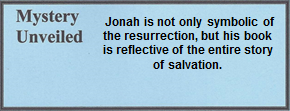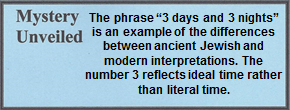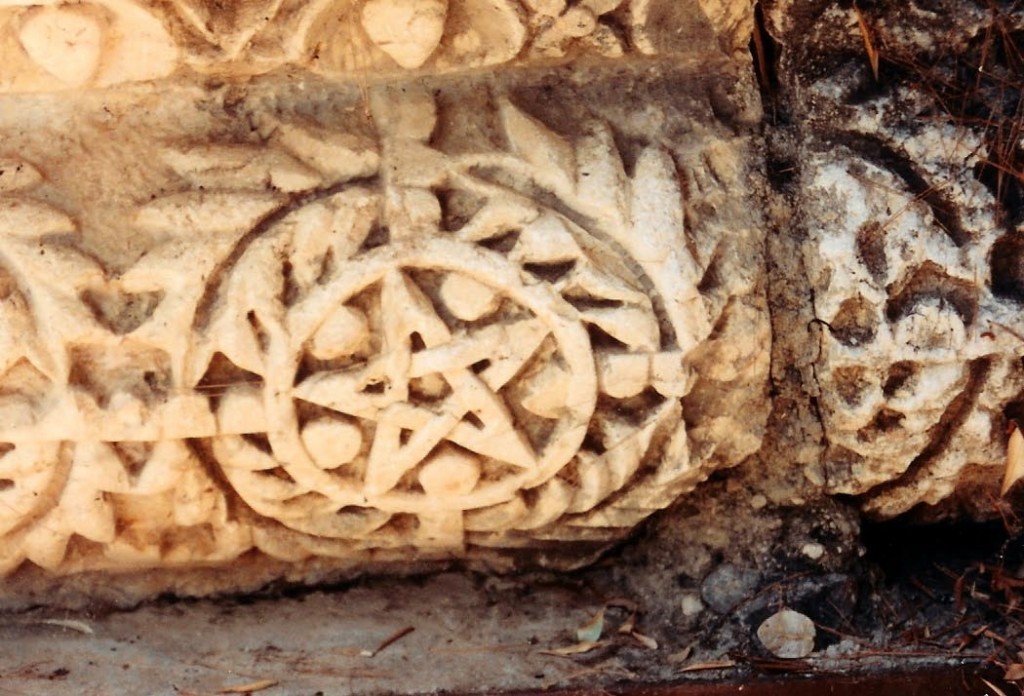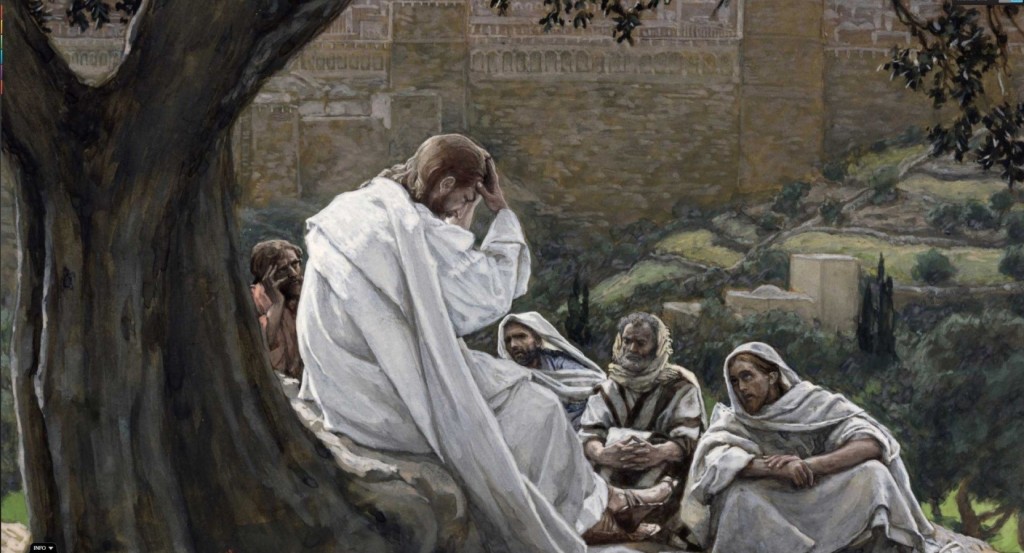09.01.05 Mt. 12:38-42; (See also Lk. 11:29-32)
THE SIGN OF JONAH; REFLECTIONS UPON KING MANASSEH AND KADESH-BARNEA
38 Then some of the scribes and Pharisees said to Him, “Teacher, we want to see a sign from You.”
39 But He answered them, “An evil and adulterous generation demands a sign, but no sign will be given to it except the sign of the prophet Jonah. 40 For as Jonah was in the belly of the huge fish three days and three nights, so the Son of Man will be in the heart of the earth three days and three nights. 41 The men of Nineveh will stand up at the judgment with this generation and condemn it, because they repented at Jonah’s proclamation; and look — something greater than Jonah is here! 42 The queen of the south will rise up at the judgment with this generation and condemn it, because she came from the ends of the earth to hear the wisdom of Solomon; and look — something greater than Solomon is here!
It is interesting that Jesus made a reference to Jonah because this prophet was a weak, stubborn, and disobedient individual who experienced a profound theological and attitudinal adjustment. With a new God-given outlook on life, he completed the calling to bring repentance to the Assyrian royal court in Nineveh. Furthermore, Jonah is symbolic of the resurrection and his book sets forth the entire story of salvation because it prophetically foreshadows God’s relationship with man, from the first advent of Jesus to His return. That may be why he is the only prophet with whom Jesus directly compares Himself.
09.01.05.Q1 What was the sign of Jonah?
Jesus mentioned the sign of Jonah, but did not say what it was. He didn’t need to, because everyone understood what He was speaking about; it related to both time and resurrection. In fact, there are four features or aspects to the sign:
- Just as Jonah was entombed in the belly of the great fish for the proverbial “three days and three nights,” so likewise Jesus was entombed in the earth for the same time.[1]
- The ancients believed the bottom of both the Mediterranean Sea and the Sea of Galilee was the abyss or place for the dead. Some believed it was also the entrance to hell. In the logic of first century listeners, just as Jonah went down to the place of the dead, Jesus did likewise going to the entrance of hell.
- Just as Jonah was resurrected to life when the mighty fish regurgitated him on the shore, so Jesus was resurrected to life from the tomb (see Acts 1:7).[2] In fact, the entire book of Jonah is a story of salvation that prophetically foreshadows God’s dealing with man – from the first coming of Jesus to His return.
- Just as Jonah preached in Nineveh for forty days concerning the coming judgment, so likewise the gospel was preached to the Jews for forty years before judgment fell. The destruction of Jerusalem and the temple occurred exactly forty years after the death and resurrection of Jesus. Those forty years were a probationary period for the nation of Israel and its leadership, a “prophetic type of Jonah,” which Jesus said would be a sign to validate His Messiahship.

But the leading Pharisees demanded that “we want to see a sign from You.” According to the Jewish Bible, a sign is “an outward compelling proof of divine authority.”[3] This was an incredible request since Jesus had already performed so many miracles, including the messianic miracles. However, by stating that they were a wicked and adulterous generation that was looking for a sign, He did not mean everyone. That statement was directed only to those who had seen Him perform signs and wonders and still refused to believe. Now they had the audacity to make this request. What would another miracle prove? It was a point of rejection.
The religious leaders represented “national Israel.” When they rejected Jesus, in effect, “national Israel” rejected Him, and in response Jesus was going to reject national Israel. As such, He began a new phase of His ministry focused solely on those who put their faith in Him.[4] In addition to His instruction about the purpose of the Torah, as it is applied to life, Jesus performed three messianic miracles[5] plus one.
- The healing of a Jewish leper (Mk. 1:40-45; 06.03.08).
- Casting a demon out of a mute person (Mt. 9:32-34; 08.06.08).
- Healing a man who was born blind (Jn. 9:1-12; 11.02.21).
- These profound messianic miracles were surpassed by the grand finale of all miracles – raising Lazarus to life after three days of death. A miraculous performance of the Divine!
However, in the course of time, the Sadducees and Pharisees responded by presenting three signs that they rejected the “sign of Jonah.”
- They rejected the resurrection of Lazarus from the grave (Jn. 11).
- They rejected the resurrection of Jesus (Acts 1:7).
- They martyred Stephen
Since Jonah is symbolic of a resurrected life, the rejection of the “sign of Jonah,” is therefore, the rejection of the message of salvation. That rejection of Jesus was a national decision and the nation would suffer the consequences of it. As previously stated, decisions determine destiny.
“An evil and adulterous generation.” The word adulterous (Gk. moichalis, 3428) means one who has unlawful intercourse with the spouse of another,[6] which, in this case, also means apostate.[7] Since God desires a close relationship with His people that is both a covenant and mirrors a marriage covenant, departure from faith and obedience is seen as adultery and apostasy.
In this passage, Jesus did not refer to the entire generation of all Jews, but only to the generation of religious leaders who were demanding that hardworking, honest Jewish people keep laws never endorsed by God. The Sadducees and the leading Pharisees had broken the covenant (marriage tie) between Jehovah God and His people. The term adultery was also frequently used by the prophets to describe the spiritual prostitution of Israel’s leaders.[8] With this phrase, Jesus applied all the words of condemnation spoken by the prophets to the religious elite. They were fully aware of His power and did not need to see another sign, but needed to repent. They had become so arrogant, that, in their thinking, they could do no wrong if they followed their own moral religious code. However, God intended them to be a chosen people to serve Him, a mission in which they failed miserably. Both Jesus and Jonah were delivered from death. The reason why the men of Nineveh will someday stand in judgment against unrepentant Israel is because Nineveh repented, but national Israel did not.[9]
The phrase greatly angered them because it connected them to horrific events in their history; several periods of cultural and spiritual decadence when their forefathers were an “evil and adulterous generation.” Two examples are:
- In the sixteenth century B.C., shortly after Moses led the Israelites out of the Egypt, they arrived at Kadesh-Barnea. From there he sent twelve spies to appraise the land of Canaan. Their mission was not to determine if they could defeat the Canaanites, but how to plan a military strategy. As the story goes, they went on a forty day mission and upon their return, only Caleb and Joshua reported the land could be conquered (Num. 13:13-33). The other ten spies convinced the Israelites that conquest was impossible. In essence, Caleb and Joshua had faith that God would help them, but the others did not. Consequently, the Israelites worried they would be defeated if they confronted the Canaanites, so they murmured and complained against Moses and God. For that reason God sent them back into the desert for forty years until that “wicked and adulterous” generation passed away (Num. 14). Therefore, when Jesus used the phrase “a wicked and adulterous generation,” He connected to the sins of their forefathers who were sent back into the desert. The statement had profound ramifications.
- In the 7th century B.C., King Manasseh who, for fifty-five years, led the Jewish people into idolatry (2 Kg. 21; 2 Ch. 28) in a number of ways.
- According to the American Standard Version, Manasseh “practiced augury, and used enchantments, and dealt with them that had familiar spirits and with wizards” (2 Kg. 21:6).
- He practiced, “augury,” which the pagans believed was an effective method of determining the will of the gods by studying the sounds and flight patterns of birds.
- He had his own son and many other children burned alive as an offering to their god Molech in the Hinnom Valley.
Manasseh was one of the most wicked monarchs in Israel’s history, yet at the end of his life, he repented and returned to the Lord. However, the Jewish people at the time of Jesus considered the generation of this king as “a wicked and adulterous generation.” But the implications of the phrase did not end with Manasseh.
A Lesson in First Century Hermeneutics:
09.01.05.X1 Figures Of Speech. Figures of speech are not to be taken literally, but have a meaning that is culturally understood. The difficulty is, of course, that those who read figures of speech centuries later may not understand the meaning, or conclude the writer was in error. The assumption that figures of speech are to be interpreted literally has given fuel to critics, such as posed in the following question:
09.01.05.Q2 Is the phrase “three days and three nights” to be interpreted literally or is it a figure of speech (Mt. 12:40)? Likewise, was Jesus buried for three literal days and three literal nights (Mt. 27:57-28:6)?
This has been and continues to be a subject of debate among Christians. This question is an excellent example as to why it is important to understand the cultural issues of the first century Jewish people. The answer is “yes,” but only in Jewish thinking. The phrase “three days and three nights,” is not a literal phrase but a Hebraism for saying, “in three days…” The modern method of reckoning the time from Friday evening to Sunday is certainly not three days. The ancient Hebrews counted a part of a day as a whole. Therefore, any time before sunset was considered a day. A new day began at sunset, generally at 6:00 p.m., or when the first three stars were visible in the sky. Friday afternoon when Jesus died is counted as the first day, Saturday is the second until sunset, and Saturday night is the beginning of the third day. Time was reckoned likewise for Sunday morning, and hence, with Saturday, they counted three days.[10]
For further detail, consider this: This phrase has been used by critics to illustrate errors in the Bible. However, an examination of the Hebraic use of the term clarifies the mystery. At issue is this phrase: “For as Jonah was in the belly of the huge fish three days and three nights.” While this passage is a reference to the time period that Jonah and Jesus would be entombed, Hebraic scholars say that the focus is not on the number of days in the entombment (Jon. 1:3, 17), but on the resurrection that followed. Below are four examples of the phrase “three days and three nights,” used as a figure of speech.[11]
- Rehoboam told the people to see him after three days (2 Ch. 10:5, KJV), but in fact, he met with them on the third day (2 Ch. 10:12, KJV). The difference between the words “after” and “on” is significant. Unfortunately, at times the fine details of meaning are lost in translations. Matthew himself used “after three days” (27:63-64) demonstrating that he considered the equivalent to “on the third day.”[12]
- Esther fasted three days and nights (Esther 4:16), but on the third day she went to meet her king (5:1). She did not see him after fasting three complete days and nights. The phrase, “three days and three nights” is a figure of speech signifying ideal time rather than a literal time.[13] The number three means “ideal” when used in Hebraisms, as is evidenced by the frequency a concept is mentioned. Likewise when a word is reported three times, such as “holy, holy, holy,” it is given the highest Hebraic significance possible. Rarely is anything repeated three times in the Bible.[14]
- In the book of Tobit (3:10-12), a woman by the name of Sara prays for three days and three nights, but on the third day (v. 12), she ends her prayer. Obviously the Jewish audience understood that the time frame was not a literal three day and three night … seventy-two hour … period.

- The Apostle Paul counted this as three days when he said that Jesus was buried and was raised on the third day according to Scripture (1 Cor. 15:3-4). So if the apostle said that Jesus was raised on the third day, the obviously He could not have been buried the entire third day.
The emphasis should not be on the number three, but on the resurrection since that is the main point of the comparison. The problem arises when modern students read that Matthew also said that Jesus was raised to life “on the third day” (Mt. 16:21, 17:23, 20:19) and “after three days” (27:63). Furthermore, Matthew 12:39-40 stated that Jesus will rise after three days and three nights. It is difficult to believe that Matthew, who was at one time employed as a tax collector and skilled tax accountant, would make such an error in counting days and nights. As previously stated, the term “three days and three nights,” regardless of the “on,” “after,” or “and,” the term was an idiom for any time touching three days.[15] Scholars today almost universally agree that the three day formula is a figure of speech that never intended to have any literal interpretation.[16]
There is also another point to be considered: In the Jewish tradition, a day and a night was known as an Onah, and a full 24-hour Onah or part of an Onah was considered a whole unit.[17] Likewise, parts of three days and three nights are treated as a whole, even if it was only 36 hours (the time from death to resurrection). In modern Western thinking, readers separate the day from the night and count them separately. But this was not so in biblical times.[18]
Since the life and death of Jesus was reflected in Hebrew typology,[19] His death occurred when lambs were slain on Friday in the temple and His resurrection when the high priest stood in the temple and waived the grain offering (of barley) before our Lord on Sunday morning declaring “Blessed are you O Lord, who brings forth the bread of life from the earth.”[20] The time of the events strongly suggests that it was then that Jesus walked out of the tomb. The period of “three days and three nights” was understood to fit within these two sacrificial events in the temple.
< ——————————————– >
A Lesson in First Century Hermeneutics:
09.01.05.X2 Clarification Of Old Testament Passages
At times a New Testament passage brings clarification to a passage in the Old Testament. An example is this: “The men of Nineveh … the queen of the South.” When Jonah went to the Assyrian city to preach the message of repentance, the Gentile men of Nineveh recognized him as a prophet of God, accepted his message, and repented. Likewise, the Queen of Sheba, also a Gentile, recognized that the divine wisdom possessed by Solomon was of God.[21]
Jesus was now before the Jewish leaders and the proud descendants of Abraham were assured of their religious knowledge, but failed to recognize Who was standing before them. Jesus, in essence, said that the Queen of the South traveled a great distance to hear Solomon but the Pharisees were not at all interested in hearing anything of the Kingdom of God. In the first century the Kingdom of Sheba no longer existed and, therefore, Jesus used the Hebrew word for “south” (teman). This word is the origin of the name of modern country of Yemen located in the southern corner of the Arabian Peninsula. Jesus continually interpreted and clarified Scripture. All sages and rabbis did this, and the student of biblical history must be aware of this hermeneutic. This method of first century clarification explains some of the so-called errors that critics identify in Scripture.[22]
< ——————————————– >
“Something greater than Solomon is here.” A better translation is “One greater than Solomon is here,” because Jesus was referring to Himself.[23] This was a profound statement. Solomon had immeasurable wisdom, power, and wealth, but what Jesus said of Himself surpassed that of the former king. The historical context of this passage is that first century Jews relied upon Solomon’s wisdom for the discernment needed concerning demons, as well as his power to cast them out. There is nothing in Scripture that indicates that Solomon ever cast out demons. However, since he was deemed to be the most brilliant man who ever lived, first century Jews believed that he knew how to cast out demons and had the power to do so. Whether Solomon was able to do that is not the issue, the issue is that the Jews believed that he had that power and ability. Jesus did not argue the point. He simply stated that Someone, meaning Himself, was present who was greater than Solomon.
It is quite significant that wisdom was not considered a miraculous sign. When Jesus was twelve years old He sat on the temple steps and dumbfounded the priests with His superior wisdom and knowledge, yet this was not considered a miracle. His first miracle occurred later when He turned the water into wine in Cana. He repeatedly awed the audience with His insights, knowledge, and wisdom, and at no time were any of these conversations considered miracles.
When the Pharisees requested a miraculous sign, they did not want to hear another comment about His wisdom. Every time they attempted to trap Him with a trick question, He turned their question around and made them look foolish. They wanted a “sign,” meaning a miracle such as a healing or exorcism, but not wisdom in insight. Therefore, most certainly one who had received such divine blessing of wisdom would know how to successfully cast out demons. Jesus had just healed a demon-possessed man (Mt. 12:22-30) and the conversation continued in that particular theme. Therefore, the discussion of One who is greater than Solomon is actually built upon the discussion of exorcism, and ancient writers preserved abundant clues to enhance modern understanding. Among these writers, Josephus not only preserved the extra-biblical evidence of historical exorcism, but also recorded that he personally witnessed a successful exorcism by one called Eleazar using the name of Solomon as his source of power. The historian’s understanding of Solomon explains why Eleazar and others called upon the name of Solomon for wisdom and power to cast out demons.
He also composed books of odes and songs – a thousand and five; of parables and similitudes – three thousand; for he spoke a parable upon every sort of tree from the hyssop to the cedar; and in like manner also about beasts, about all sorts of living creatures, whether upon the earth, or in the air; for he was not unacquainted with their natures, nor omitted inquiries about them, but described them all like a philosopher, and demonstrated he had exquisite knowledge of their several properties.
God also enabled him to learn that skill which expels demons, which is a science useful and sanative (healing) to men. He composed such incarnations also by which distempers are alleviated. And he left behind him the manner of using exorcisms by which they drive away demons so that they never return and the method of cure is of great force unto this day; for I have seen a certain man of my own country whose name was Eleazar, releasing people that were demoniacal in the presence of Vespasian, and his sons, and his captains, and the whole multitude of soldiers. The manner of cure was this: He put a ring that had a root of one of those sorts mentioned by Solomon to the nostrils of the demoniac, after which he drew out the demon through his nostrils; and when the man fell down immediately, he adjured him to return into him no more, making still mention of Solomon, and reciting the incarnations which he composed. And when Eleazar would persuade and demonstrate to the spectators that he had such power, he set a little way off a cup or basin full of water and commanded the demon, as he went out of the man, to overturn it and thereby let the spectators know that he had left the man. And when this was done, the skill and wisdom of Solomon was shown manifestly; for which reason it is, that all men may know that vastness of Solomon’s abilities and how he was beloved of God, and that extraordinary virtues of every kind with which this king was endowed may not be unknown to any people under the sun; for this reason, I say, it is that we proceed to speak so largely of these matters.
Josephus, Antiquities 8.2.5 (44-49)
However, what the first century exorcists did not realize is that, if Solomon did cast out demons, he truly would have had divine wisdom and would not have used first century rabbinic incantations and methods. Nonetheless, Josephus clearly believed that:
- Solomon had the divine knowledge and power to cast out demons, and
- Solomon’s power was transferred to future generations to continue the same.
His wide range of wisdom and expertise was connected with every known science and philosophy by the second century B.C. Furthermore, Josephus linked the creation of effective casting rituals and incarnations to Solomon. The historian did not believe this activity was a form of mythology, but a serious event in one’s life.
The unknown author of the extra-biblical book titled, Wisdom of Solomon, also described the reflections and a functional knowledge of Solomon’s wisdom.[24] This book, written in the first century B.C., reveals the popularity of Solomon as related to the exorcisms of demonic spirits in chapter 8. In the passage below, note the phrase in Hebraic poetry “the violent force of spirits,” and that it is associated with the “reasoning of men.” [25] This book is in a class of writings that comprise the Apocrypha, and was written in the first person.[26]
For both we and our words are in his hand, as are all understanding and skill in crafts. For it is he who gave me unerring knowledge of what exists,
To know the structure of the world
and the activity of the elements;
The beginning and end
and middle of times,
The alterations of the solstices
and the changes of the seasons,
The cycles of the year
and the constellations of the stars,
That natures of animals
and the tempers of wild beasts,
The powers of spirits
and reasonings of men,
The varieties of plants
and the virtues of roots;
I learned both what is secret
and that is manifest,
For wisdom, the fashioner of all things, taught me.
Wisdom of Solomon, 8:17-22[27]
When reading the Wisdom of Solomon, the reader may conclude that the author enhanced the image of the ancient king. Yet, Scripture precisely indicates that King Solomon was, in fact, the wisest man upon the earth and no other would ever be like him (1 Kg. 3:12). Therefore, is it possible that modern scholars have failed to consider that Solomon may have had the knowledge to expel demons? There is a growing body of scholars who, after reading ancient documents, believe that Solomon was frequently referred to as a powerful authority in exorcisms and incantations.[28] It has been suggested that the writer of the Wisdom of Solomon exaggerated the activities of famous king, but many Jews of the first century fully believed this book to be historically accurate.
Another source is the Testament of Solomon which is in a class of books known as the Pseudepigrapha and was written sometime between the first and third centuries A.D. It is literary evidence of how much Greek paganism influenced Judaism. While this book is of late date, it reflects the thinking common during the life of Christ as well as that of the Essene community, as noted in their Dead Sea Scrolls. The Testament is a folktale about Solomon’s building activity concerning the temple, as well as ancient lore concerning magic, demonology, and primitive medicine. Below is a quotation concerning exorcism. It is noteworthy that the source of spiritual power and authority is God followed by the secondary source, Solomon. When Jesus said He was greater than Solomon, He was placing Himself equal with God.
Testament of Solomon, Son of David, who reigned in Jerusalem and subdued all the spirits (demons) of the air, of the earth, and under the earth; through them he also accomplished all the magnificent works of the temple; what their authorities are against men, and by what angels these demons are thwarted.
Blessed are you, Lord God, who has given this authority to Solomon. Glory and power to you forever. . .
Testament of Solomon, Prologue[29]

According to the Dead Sea Scrolls, powers to manipulate demonic spirits and create spells are first credited to God, then to Solomon.[30] This priority of authorized power and authority (i.e., God first) is also found in a magical papyrus document dated between second century B.C. and A.D. 70. It is similar to the portion of a much later date found in the Apocryphal Psalms. Note the following reading:
Of David. Concerning the words of the spell in the name of YHWH…of Solomon, and he will invoke the name of YHWH to set him free from every affliction of the spirits, of the devils, Liliths, owls and jackals. These are the devils, and the pri[nce of enm]ity is Belial, who rules over the abyss. [Text missing] to [text missing] and to magnify the God of wonders [text missing] … the sons of his people have completed the cure, … [those who]… have relied on your name. Invoke … guarding of Israel. Lean on YHWH, the God of gods, he who made the heavens and the earth and all that is in them, who separated light from darkness….
Dead Sea Scroll, Apocryphal Psalm of Exorcism (11Q11[11QPsApa]), 2:2-12[31]

09.01.05.A. THE ANCIENT SEAL OF SOLOMON CARVED IN STONE. RIGHT: The Seal of Solomon (early 4th century A.D.) is an encircled 5-pointed star, like this one at Capernaum. It is believed by some scholars to have originated in Greek art and became known as the Star of Solomon. Photograph by the author.
This is clear evidence that exorcism was common in the days of Jesus, and the spiritual power was attributed to YHWH (God) and the ancient king.[32] Now Jesus stood before them and boldly stated that, “Something (or One) greater than Solomon is here.” This had a profound effect as He had cast out demons without any special incantations, root or herbal remedies, or references to Solomon, but simply by the authority of His spoken word. Therefore, Jesus demonstrated that He was greater than Solomon.[33]
[1]. See the use of this figure of speech in 09.01.05.Q2 below.
[2]. Garr, Restoring Our Lost Legacy. 59-60.
[3]. Bock, Jesus According to Scripture. 224-25; Ex. 4:8-9; Deut. 13:1; Isa. 7:10-17, 38:7.
[4]. Pentecost, The Words and Works of Jesus Christ. 208-10.
[5]. For more information on the messianic miracles, see 06.03.08.Q2.
[6]. Vine, “Adulterer (-ess), Adulterous, Adultery.” Vine’s Complete Expository Dictionary. 2:14.
[7]. Barclay, “Matthew.” 2:49.
[8]. cf. Isa 57:3ff; 62:5; Ezek. 23:27; James 4:4; Isa. 50:1; 57:3; Jer. 3:8; 13:27; 31:32; Ezek. 16:15, 32, 35-42; Hos 2:1-7, 3:1, et. al.
[9]. Carson, “Matthew.” 8:297.
[10]. Bivin, “How Long was Jesus in the Tomb?” Yavo Digest. 2:4, 1, 3.
[11]. Typical Old Testament references include passages such as Isaiah 53. However, for an interesting study on ten examples of resurrection typology, including third day typology in the book of Genesis, see Nicholas P. Lunn, “’Raised on the Third Day According to the Scriptures’: Resurrection Typology in the Genesis Creation Narrative.” 523-35.
[12]. Pickup, “’On the Third Day’: The Time Frame of Jesus’ Death and Resurrection.” 514 n14.
[13]. Lunn, “Raised on the Third Day According to the Scriptures.” 526.
[14]. Jeffrey, Unveiling Mysteries of the Bible. 181-84.
[15]. Fruchtenbaum, The Jewish Foundation of the Life of Messiah: Instructor’s Manual. Class 25, page 21.
[16]. Pickup. “‘On the Third Day’: The Time Frame of Jesus’ Death and resurrection.” 514.
[17]. Lightfoot, A Commentary on the New Testament from the Talmud and Hebraica. 2:210.
[18]. See also 17.02.02.Q8.
[19]. Typical Old Testament references include passages such as Isaiah 53. However, for an interesting study on ten examples of resurrection typology in the book of Genesis, see Nicholas P. Lunn, “’Raised on the Third Day According to the Scriptures’: Resurrection Typology in the Genesis Creation Narrative.” 523-35.
[20]. Garr, Restoring Our Lost Legacy. 145.
[21]. 1 Kg. 10:1-13 = 2 Chron. 9:1-12; Josephus, Antiquities 8.6.5-6 (165-175); Bock, Jesus According to Scripture. 260-61.
[22]. Bivin, “The Queen of Teman.” Yavo Digest. 2:3, 19.
[23]. Perkins, “Greater than Solomon.” 207-17.
[24]. The Wisdom of Solomon was written in the first century B.C. See Appendix 22 for more information on “Major Prophecies Of The Last Days And The Second Coming Of Jesus.”
[25] See 02.02.01.V for more information on this subject.
[26]. The reader is reminded that quotations from non-biblical sources are not to be understood as being of equal authority with the biblical narratives. See 01.02.04 and 02.02.01.V.
[27]. Cited by Metzger, The Apocrypha of the Old Testament. 110. The Wisdom of Solomon belongs to a classification of extra-biblical books known as the Apocrypha. See 02.02.03 “Apocrypha;” 08.04.07.Q2 “Why did Jesus teach with parables?” and “Apocalyptic Literature” in Appendix 26 for more information.
[28]. Perkins, “Greater than Solomon.” 211.
[29]. Cited by Charlesworth, The Old Testament Pseudepigrapha. 1:960.
[30] See 02.02.01.V for more information on this subject. THe book of Tobit illustrates how Jewish people in the Inter-Testamental Period understood demons, the importance of prayer, fasting, and giving alms. This is especially important relative to Matthew 6.
[31]. 2:2-12 = Column 2, lines 2-12; Martinez, The Dead Sea Scrolls Translated. 376.
[32]. Today, some have claimed that the 5-pointed star originated with the occult and other pagan religions. However, it is because Solomon was said to have had mystical powers, that his symbol was eventually used in cultic rituals. Other scholars say that the Seal of Solomon, like the 6-pointed Star of David, did not originate in the first century, but were developed in later centuries.
[33]. Neither Solomon nor Moses left any writings on how to deal with demonically possessed individuals. Beliefs and superstitions related to Solomon appear to have originated with Inter-Testamental rabbis, not the famous king.






